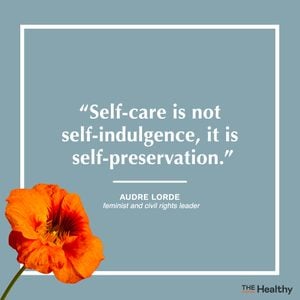What Are the Dimensions of Wellness—How to Make Them Work for You
Updated: Mar. 16, 2022
Knowing your weaknesses and strengths may help you change your life.
Pop quiz: What’s the definition of health? If you’re like most people, you likely answered with the usual suspects—healthy weight, low cholesterol, physically fit. You might have branched out and added good mental health, too.
However, sticking to just our brains and bodies gives us a very limited view of all the things that go into our overall health and well-being, says Laurel Mellin, PhD, health psychologist, founder of emotional brain training, and associate clinical professor of family and community medicine and pediatrics at the University of California San Francisco. (Here are the 50 signs you’re “healthy” from every type of doctor.)
To help people broaden their scope of health, the “8 dimensions of well-being” model was created. It’s popularly credited to the University of Michigan Wellness Institute. But variations of it appear in many academic publications going back decades, including this comprehensive overview published in 2017 by Rutgers University. The model shows eight interlocking shapes—usually circles or petals—with each representing a different facet of health. Where they all intersect in the middle is labeled “well-being.”

Why do you need a well-being model?
Optimal well-being exists on a spectrum. On one end there is the overly simplistic view that as long as your blood tests are normal then you are perfectly healthy. On the other end are the more obscure aspects of health that are studied and pored over in endless articles, books, and publications. (Not to mention all the misinformation out there, like these rampant health myths that need to die.)
Trying to figure out what you need or don’t need can get complicated fast. And you can burn out on all the recommendations of things you should and shouldn’t be doing to take care of yourself.
Good news: All of these data points for bettering your health can be put into eight categories or “dimensions” that allow you to simplify your pursuit of wellness.
“Breaking ‘wellness’ into parts actually helps us think of it in a more holistic way by showing us how interrelated these aspects of our lives are,” says Scott Kaiser, MD, director of cognitive health at the Brain Health Center at the Pacific Neuroscience Institute and a geriatrician with Providence Saint John’s Health Center in Santa Monica, California. “Each of these ‘dimensions’ overlap and are equally important to not just how long your life is, but also the quality of your life.”
How to use this to improve your life
Looking at health from this viewpoint can help you identify your personal weak spots and make health goals targeted to your unique situation, Dr. Kaiser says. “Improving in one dimension will cause a cascade of positive changes throughout all the other dimensions.” (Check out these self-love quotes to stay loving and positive while you focus on what you need to change.)
To get the most out of a well-being model, Dr. Kaiser recommends the following:
Schedule regular self-assessments. Look through each dimension and rank yourself on how well you are doing. Highlight areas that need improvement, look for dimensions that are unbalanced, and note those you excel in.
Share your assessments with a loved one. It can be hard to be honest about your own strengths and weaknesses. So it’s worth asking a close friend or family member to go through it with you and help you identify areas of concern and growth.
Talk to your healthcare team. Your doctor, therapist, and other medical professionals can give you extra insight into steps you can take to improve your well-being.
Write down your goals. An unwritten goal is just a wish. So commit to improving your health and happiness by writing down a manageable goal for each dimension.
Ready to start?
The 8 dimensions of wellness
Each dimension of wellness represents a different aspect of well-being. Here, we break down what each one means and how you can use it. (Use these tricks to make your health goals stick.)
Physical
This is the one people tend to hyper-focus on and that’s not necessarily a bad thing, Dr. Kaiser says. “Everything you do depends on your physical health so if you’re not sure what to do first, this area is a great place to start,” he says. Plus, it’s generally easier to measure success in this area as much of it can be quantified, like pounds lost or grams of fiber eaten. (These are the top health mistakes you’re probably making.)
Includes: exercise, nutrition, sleep, and preventative medical care
Intellectual
Humans are defined by our disproportionally large brains and for good reason. Being able to think, invent, and solve issues is key to staying alive and well. Plus, many of us derive a great deal of satisfaction from intellectual pursuits, to the point where many people define themselves by their degree or area of expertise. (Do you have any of these weird habits that prove you’re smarter than most people?)
Includes: education, creativity, hobbies, problem solving, and exploring new things
Emotional
If our brains are what make us human, then our emotions are what make us feel human. “The emotional brain is the seat of the soul,” says Mellin. Our emotions shape how we see our experiences and play a huge part in our sense of satisfaction and well-being. “Eighty percent of health problems today are due to the downstream effects of stress,” she adds. “So learning to break free from stress will benefit every other aspect of your life.”
Includes: stress management, mindfulness, cultivating resilience, and managing depression and anxiety
Social
This is the most underappreciated aspect of health, according to Dr. Kaiser. “Loneliness and isolation are the biggest predictors of poor physical health and cognitive decline as people age, even more than diet or exercise,” he says. “We are social beings and if you don’t have a social support network, loneliness will shorten your life.”
Includes: clubs, community service, volunteering, visiting loved ones, and digital communications
Spiritual
Everyone has to find a sense of purpose or meaning in life, Mellin says. Some people find this through organized religion while others focus on connecting with a feeling of something bigger than themselves, whether that’s the universe, a higher power, or humanity. The key is to find something that motivates you to not just survive but thrive.
Includes: going to church, meditation, spiritual retreats, and yoga
Financial
Money can’t buy happiness, but it sure can buy a lot of things that help you be happy and healthy, says Genie Zeigler, a financial advisor and senior vice president at Merrill Lynch. Those include basic needs such as nutritious food and proper healthcare, as well as higher needs like philanthropy. For many people, however, money is one of the biggest sources of stress and grief. Learning to manage your money, saving, and spending consciously, can have huge payoffs in all other areas of your life, she says.
Includes: budgeting, saving, investing, donating to charity, and moderate buying
Occupational
Having a job is a great start. Having a job you love is even better. But the key to occupational well-being is to have a career map, Zeigler says. “This map shows your goals for your career and retirement and what you can do to achieve those,” she says. Losing your job or feeling stuck in a rut in your career can negatively impact your health and happiness or even lead to an existential crisis.
Includes: employment, resume building, career counseling, learning new skills, and education
Environmental
Your health is directly tied to the health of the planet. After all, if Mother Earth can’t breathe then neither can we. Yet taking care of our environment is an oft-overlooked aspect of well-being, perhaps because dealing with things like climate change and pollution can feel overwhelming, says environmental and eco-anxiety expert Erica Dodds, PhD, chief operating officer at the Foundation for Climate Restoration. Fortunately, everyone can do something to take care of the environment and even little changes add up—for your well-being, as well as the earth’s, she says.
Includes: spending time in nature, picking up litter, recycling, lobbying for climate change policies, and cleaning your own home and yard
Weaknesses of the eight dimensions of wellness model
This model provides a comprehensive look at dimensions of health and happiness, but they aren’t the only dimensions and these may not be the ones you need to personally thrive, Dr. Kaiser says. For instance, his personal model would add a circle for beauty and another for helping others. And, for him, the spiritual and emotional dimensions could be combined into one. In addition, while there is research to support the importance of each aspect of health, there is no definitive research to back this specific model.
“Use the model as a starting point or a guide in how you think about your well-being—not an absolute,” he says.



